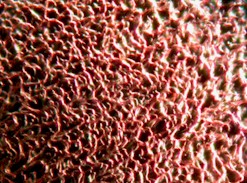One of the theories of mold is that only
certain molds produce toxic metabolites. Of these,
the trichothecenes are the ones most discussed but there
are also hemolysins, chemicals that cause rupturing of red
blood cells and sometimes severe anemia.

Before trying to say anything
on the subject of mycotoxicity, I want to reiterate something
I have said before: mold can and will and does destroy
blood. In my observations of live blood, it can achieve
this in at least three ways:
- By devouring the red blood cells while
in the vegetative state. In this case, the RBCs travel
through the hypha where they are exposed to acids and enzymes. At
the end of this journey, the formerly discrete RBCs are
liquefied and presumably also predigested. It is
pointless to get into a debate over this phenomenon until
one has actually seen this in a microscope.
- By spraying something on substances that
causes a nearly total dematerialization of the cells. It
is unclear to me whether the mold "eats" these substances
or merely causes their rapid decomposition.
- By releasing a chemical that causes very
rapid hemolysis. The interesting feature of this
activity is that the shells of the RBCs do not disintegrate
and are not used as food by the mold. Therefore,
this side effect of mold exposure occurs independently
of what is generally called the vegetative state.
| This is a photomicrograph
of red blood cells that have lysed. The curious
fact about such occurrences is that the blood does not
decompose further, at least not on the slide. It
remains microbe-free and frozen in time. |
 |
There is another factor that can also
lead to serious blood loss and that is a consequence of
the colonization and vegetative behavior of mold. This
can lead to tissue perforation and hemorrhaging. It
can also result in two entirely separate physiological
developments:
- The appearance of what seem to be growths,
such as tumors; and
- Loss of tissue that varies from demyelination
of nerve sheaths to tiny fissures and large holes where
all the tissue has been either eaten or dematerialized
by the mold or the mycotoxins.
If all this were not enough, it is clear
that the mycotoxins cause damage to tissues, including vital
organs. This can interfere with the functions of the
affected tissues and organs and lead to organ failure. Some
of the mycotoxins are scarring and cause sclerosis whereas
others interfere with body chemistry and organ integrity.
All in all, this is a grave picture and
one that is nearly always underestimated by all but the best
informed patients and a small number of health care professionals
who are risking their reputations by stating matters that
are nearly always met with resistance by the uninitiated.
Many blessings,
Ingrid Naiman
21 October 2006
To be notified when there
are new posts, please subscribe by entering your email address
in the box below. You will receive an email asking you
to confirm your subscription; you can unsubscribe at any time
using the link at the end of any email you receive. Be
sure to put moldmisery@bioethika.com as an accepted email correspondent
or the emails will bounce. This is especially important
for AOL subscribers.





